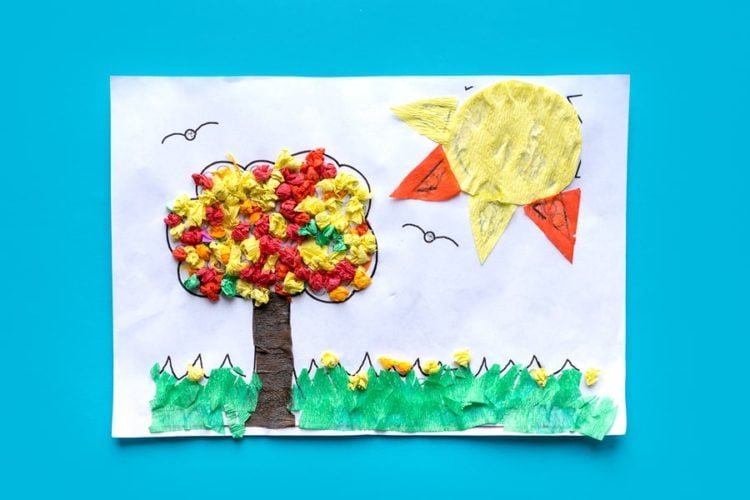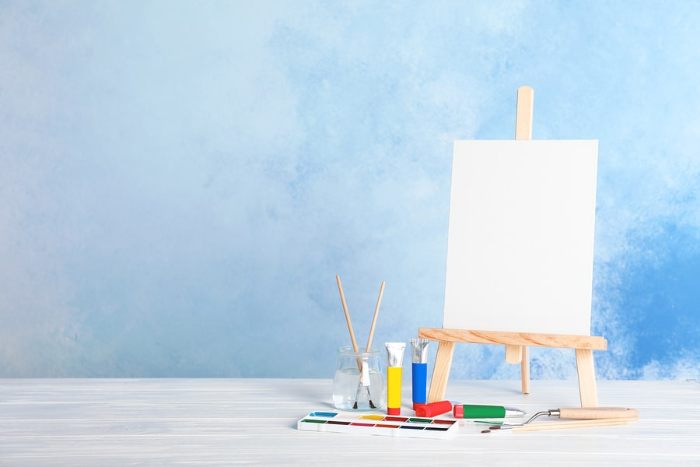Art is an integral part of every young child’s life and important for healthy development. Children are naturally drawn to creative expression.
A child who is faced with some paper and pencils will seldom need encouragement to start drawing.
You may be wondering how you can extend your children’s creative abilities. It’s as simple as giving kids opportunities to experiment with different art materials and tools.
Here’s what art is, how you can teach art to children and also some of the many benefits of creative art in child development.
What are Art Activities?
What are good activities for preschoolers? Art activities are not all made equal. Let’s take a look at this piece of art:

Sure it looks beautiful, but I’m willing to bet a child did not draw this and it was a photocopied outline of a tree, grass and sun, probably given to the whole class to complete with instructions.
The problem with these kinds of art activities – where the end product must look like the model – is that there is really very little creativity that goes into them.
The child completing the above activity was told exactly how to complete this picture, and it probably looked the same as every other child’s.
Now sometimes there is a place for these kinds of activities, like when you have an idea for a father’s day card you’d like to make with your child and you want it to at least resemble a card.
However, these shouldn’t be the norm at preschool, and they shouldn’t be the norm at home either.
Let’s roughly group art activities into three groups:
- Art that follows exact instructions and looks like the model
- Art that is completely child-led and free
- Art that is adult-guided but quite free
For example, if you take out paper plates to make animal masks or offer your child some stamps and an ink pad, you are guiding the activity. This is great because you are introducing your child to new ideas and new materials that he may not have had exposure to.
The important thing is to then allow your child to use his creativity and not dictate exactly how the activity should be carried out.
The Process of Teaching Art to Kids
You can teach your kids art by focusing on the following principles.
Understand that Art is Natural for a Child
Children want to express themselves and be creative. They are naturally drawn to creating. All they need are materials and an opportunity and they will create.
You Don’t Really Teach Art, You Let it Happen
You don’t teach a child to draw by explaining and showing them how to make a house or how to make a circle for the sun.
You teach them to draw by giving them enough opportunities to draw so that their scribbles eventually turn into symbols and images as they grow and mature.
This is why colouring books are not great for creativity.
Art Should be Free
Your children should be free to express themselves creatively with the materials they have at hand. Limit your guidance and instructions and they will surprise you with what they can create.
Encourage open-ended preschool art activities rather than structured activities.
Show Genuine Interest in Kids’ Creations
You may not think this picture below means anything and you may dismiss it…

But one day the picture will start to look more like this…

Just because the picture doesn’t necessarily look like something recognizable doesn’t mean your child wasn’t drawing something specific.
Show interest by asking your children to tell you about their pictures and don’t dismiss it by saying “that’s nice” or something equally unhelpful.
Provide Lots of Opportunities for Creative Art
Instead of leaving the TV on for your kids, rather make art materials such as crayons and paper readily available all the time.
Provide a Variety of Materials and Tools
It is important that your child is exposed to different mediums. Offer different materials to create on – paper, cardboard, wood, fabric – and different tools – paint brushes, chalk, wax crayons, ink, markers, etc.
Encourage Process Art
You may have heard of this term before. What is process art?
Exactly as the name implies, process art is when the end product is not the main focus, but rather the process that children go through to create the art.
Real, creative art is free and child-led, focusing on the process.
As you will see in the next section, there is a mountain of learning that happens during the process and this is what really makes art great.
The 8 Benefits of Art for Children
If you look at how children’s days are structured at preschool, much of their time is spent doing creative art activities, and with good reason.
The rest of their time is usually divided between music and movement activities, storytime, outdoor and indoor free play and quiet play (with puzzles, blocks, pegboards, etc).
Children learn a great deal during art and it is one of the activities they should spend time on at home as well. It is vital for their overall development. Let’s take a look at why.
What is the importance of art in child development?

1. Fine Motor Coordination
One of the main benefits of art is the development of a child’s fine motor skills, which refers to having control of the small muscles in the hands and fingers.
Children learn to hold a pencil, paintbrush or crayon, control scissors while cutting, tear paper, mould playdough or clay, hold things while gluing them and many other skills.
2. Pencil Grip and Pre-Writing Skills
When children have enough exposure to arts and crafts, they begin to develop a mature pencil grip and hold their utensils with their fingers placed correctly. This is an important pre-writing skill.
They also learn how to draw symbols by drawing images and shapes, which later leads to writing letters.
As they get older, they develop the ability to include fine detail and control the size of their pictures or draw to scale, which is necessary for learning letter formation and how to space letters on a line.
With the ability to draw a picture of a person standing on the ground and no longer floating in the air, comes the ability to write on a line.
3. Planning
When children are exposed to creative activities they develop the skill of planning, which is important during the formal school years. They learn how to plan ahead of beginning a project.
They need to know, for example, how they will fit all the family members on the page or how they will keep the wings of the airplane from falling off.
This kind of planning, which they learn through years of practice, is later translated into planning formal tasks, written and otherwise.
4. Visual Perception
An important determinant of future reading success, visual perception is the brain’s ability to understand and make sense of what the eyes see. Art is a visual learning experience that will greatly improve a child’s visual perception.
Children learn visual perceptual skills such as:
- Discrimination – the ability to see similarities and differences.
- Memory – the ability to remember what is seen.
- Sequential memory – remembering what is seen in the correct order.
- Comprehension – understanding what is seen.
- Perception of shapes – distinguishing between patterns and shapes.
- Depth perception – the ability to judge how far something is.
5. Concept Formation
When creating, children are expressing ideas they have in their minds or images they have seen and experienced. This helps them learn and solidify these new concepts and ideas.
6. Concentration
Any activity that requires children to focus for a period of time will greatly improve their overall concentration span.
Since art is so fun and engaging – and easy to get lost in the process – it slowly stretches a child’s ability to concentrate for longer and longer periods over time, until they are ready to start formal learning.
7. Creativity
Naturally, creative art builds creativity in children. They learn to work with different materials, mediums, colours, textures, etc.
The more freedom they have to explore the materials, the more they develop this ability.
8. Problem Solving
Interestingly, being creative involves a lot of problem solving. Children are faced with challenges such as:
- How to fold a paper.
- How to make two items stick together.
- How to space the pictures on a page.
- How to mix colours to get the desired shade.
- Which writing tool to use on a particular surface.
These kinds of informal learning experiences go a long way in preparing children for serious problem solving in later years.
These are just a few of the benefits of creative art in early childhood.
Here are some great examples of art activities for preschoolers and kindergarteners.


Cleshonda Gates
Monday 17th of February 2025
Hi I’m a toddler teacher and I love all the ideals Can you please send more .
Tanja McIlroy
Wednesday 19th of February 2025
Hi, thank you. There are so many more ideas in the topics here: https://empoweredparents.co/